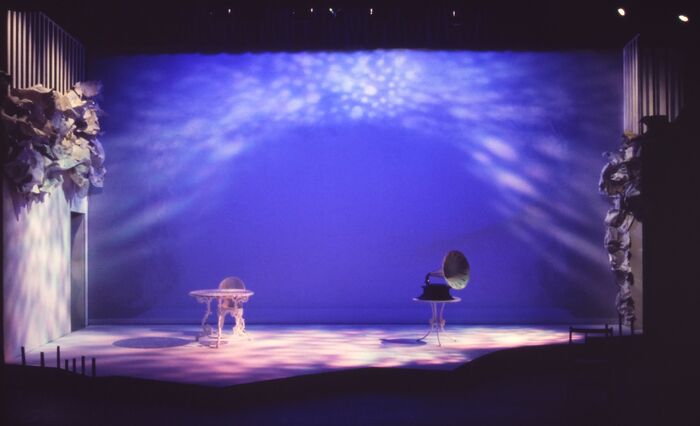The introduction of the ellipsoidal reflector spot in the mid 1930s made the gobo possible – a metal pattern that creates textured light in a simple form of projection. Since then, gobos have greatly enriched the expressive potential of lighting.
Since theatre came indoors, light has been fundamental to the theatrical experience. Light, and its necessary counterpart, shadow. Adolphe Appia (Q249), in his reforms of stage lighting, recognised that light was only meaningful – only visible – in the presence of shadow. Sculptural light, that defines the shapes and form of the objects and people on stage, was central to his proposals. As the incandescent lamp (Q3120) was introduced and developed, intense, directional spotlighting became readily available, and a new language of light evolved that would continue to reshape stage lighting through the remainder of the 20th century.
In 1933, two American companies, Century Lighting and Kliegl Brothers, each launched their version of a new type of light: the ellipsoidal reflector spotlight (ERS, Q30007). The ERS had its lamp placed at one centre of an ellipsoidal reflector; at the other centre was a metal plate with a circular hole – the ‘gate’ – with a lens system that projected an image of the gate onto the stage. The ERS combined the optics of the spotlight and the projector, the result being a spotlight that could project the image of anything placed in the gate. The arrival of the ERS in Europe had to wait for suitable lamps to be produced, but it took even longer for the full potential of the ERS to be realised by lighting designers.
The gobo (Q3117) is a template, generally made of metal but sometimes a glass-metal composite, which can be placed in the gate of an ERS, so that the pattern cut into the metal is projected onto the stage. The origins of the gobo are somewhat unclear, but certainly by the late 1950s and early 1960s lighting designers such as Richard Pilbrow and Francis Reid were making gobos by drilling holes into sheet metal, to create what were then termed ‘dapples’ – because they made the effect of broken light coming through the foliage of trees. Careful and laborious work with drills and files could achieve different textures. Later, people experimented with other readily available materials, such as aluminium foil from pie dishes and take-away meals, metal drinks cans, and the litho-plate used in printing. For more detailed or precise images, manufacturers such as Rosco, Miltel and DHA started producing catalogues of manufactured designs.
Lighting designers soon discovered the rich potential of gobos for making textured light. The spotlight lens could be adjusted to give a reasonably sharp image of the gobo, but the best effects were created by defocusing the image. The limited optical quality of the lenses used in spotlights became an advantage, as the slight colour fringing added an additional organic interest to the light quality. This could be enhanced by using a ‘split colour’ gel, with two pieces of gel stuck together with clear tape. The effect was a mixture of the two colours, in complex textures. Animation wheels on the front of the light, made of textured glass or metal with holes cut in it, caused the gobo texture to undulate, adding movement such as rippling water or the wind in trees. Other devices allowed the gobo to rotate within the gate, making spinning effects, or to slide from side to side. As with gobos, what began as home-make devices were taken up by manufacturers and became products.
With the growth of automated ‘moving’ lights in the 1980s, gobos found a new role, bringing light textures not just to the theatre stage but also to clubs and live music events. Simple geometric shapes were intended less to create patterns of light on surfaces, but in the air – light beams, with bold textures revealed by haze, became a central element for music lighting. Moving the beams through the air, and rotating the gobos, added a new visual dynamism that could match the power of rock, pop and dance music.
Gobos also found uses in commercial and cultural contexts. In shops and for trade shows and business conferences, custom gobos with logos and slogans could temporarily display a company’s brand in a space with great visual impact, while in museums, text and simple graphical images could be overlaid on the walls, floors and ceilings to add drama and increase engagement.
Light and shadow are inseparable counterparts, brought together in a single instrument by the gobo. The textures produced by gobos have light and shade built in, greatly enriching the expressive possibilities of stage lighting. One mystery remains – why are they called gobos? In the USA they are called patterns, and in France a découpe, but the term gobo is used in many parts of Europe and elsewhere. It may be a contraction of ‘go-between’, a term from cinema for an object that is out of shot, used to cast a shadow, such as light through a grill or window – but no-one knows for sure.
